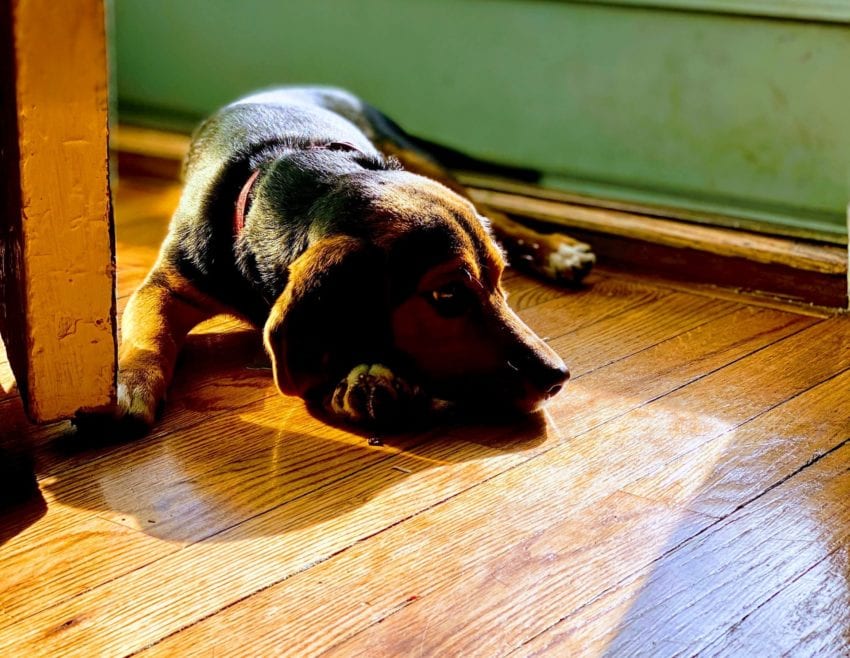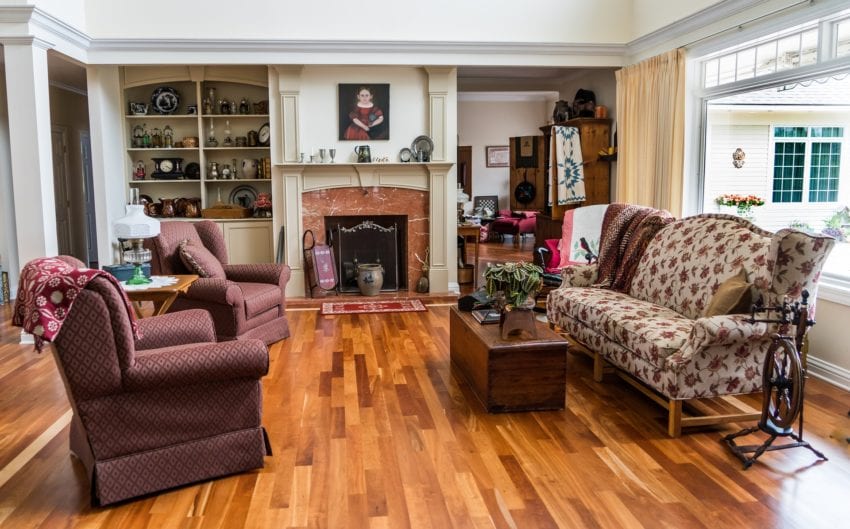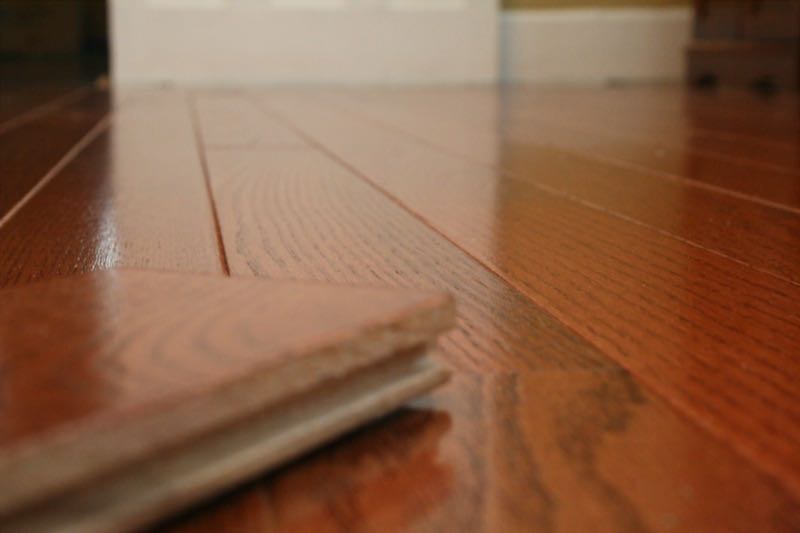Knowing how to clean wood floors and protect them isn’t difficult. You do, however, need to understand how different sealers work and the advantages and disadvantages of each. If you’ve just installed prefinished hardwood flooring, you also want to know how to protect that perfect finish.
Check out our article on how to care for wood floors for more info
Types of Wood Floor Cleaners
Two basic types of wood floor cleaners and sealers exist in the marketplace. You have penetrating sealers and top sealers. Penetrating sealers, as the name implies, soak into the wood and seal from within. When the floor becomes worn, you can re-apply penetrating sealers. This helps protect your wood floors from future dirt and wear.

Top sealers, like lacquer, shellac, and varnish stay on top of the wood. You can’t really apply these to worn spots without them showing. With top-sealers, you typically have to sand and re-apply the entire finish.
Knowing this, you can understand why we recommend you understand how to clean and protect your floors. Basic maintenance and care can really help stave off—for a time—massive reconstructive work down the road.

How to Clean Wood Floors Naturally
Several natural cleaners and cleaning methods exist on the market. Others, you can make from household products and solutions. We’ve listed some below.
Vinegar and Water
For a good all-around cleaner, add a 1/2 cup of vinegar to one gallon of water and mix. Spread it with a sponge and avoid applying it directly to the floor. This works to remove the most common dirt and grime. It restores the original finish of the wood without removing it.
Mineral Oil
Take a soft cloth and use mineral oil to clean small areas of a wooden floor. Note, mineral oil differs from mineral spirits. You can find mineral oil in most grocery stores. Oddly enough, people also used it as a sort of laxative—so you may also find it in your local pharmacy. Considered “food-safe”, mineral oil gets a lot of use as a finish on wooden bowls and butcher blocks.
Mineral spirits is more like paint thinner. You can actually use it on floors to remove very stubborn grime or oil-based stains. Typically, we wouldn’t recommend it for use on the entire floor unless you want to remove the existing oil, polish, or wax coating. You typically want to apply something new after using mineral spirits in order to protect your wood floors from further wear and staining.
How to Clean Wood Floors with Tea…Yes, Tea
You might not think we’d include tea in an article on how to clean wood floors. And honestly, we really can’t personally vouch for this one. However, a somewhat less-traditional remedy for cleaning hardwood floors involves brewing a strong pot of black tea. You then apply it with a soft cloth to the surface of the floor to pick up dirt.
The thought goes that the tea acts as an astringent to remove grease. If you want to try this, it takes about a half dozen bags per pot of water. Steep it for a bit to really allow the tea to get nice and strong.
Add this to a mop bucket and add more water as needed to cool it down. Then mop the solution with a wrung-out mop. Don’t soak the floor with the tea—you just want it damp enough to work its magic. We also recommend testing this on a small area of the floor to ensure you don’t create any stains or spotting.
Ice for Removing Gum or Crayon Stains
Now we want to show you how to clean wood floors with ice…or at least how to rid yourself of a pesky patch of something sticky. Sometimes gum or another material like crayons makes its way onto your wood floors. When that happens ice works as a remedy. After freezing gum or crayon stains with an ice pack, you can gently scrape them off once they’re hardened up.
Alcohol or Turpentine for Burn Marks
You can rub alcohol or turpentine into burn marks to ablate them away (rub them off). Your technique needs to take into account the type of wood flooring and finish, however. For example, waxed or polished wood might fix easily and then you can reapply the top coating.
With a high-gloss, lacquered wood, alcohol might help remove the burn mark, but you have to watch that finish. Ultimately, sanding and refinishing a section of flooring might be required.
For a varnished finish, you may need to rely on sanding gently to remove the burn mark from the wood surface. Pros have also told us they’ve applied a small amount of bleach to lighten areas affected by burns.
Enzymatic Cleaners
Enzymatic cleaners are best for cleaning any odorous conditions like pet stains. These cleaners actually use—as you might guess—enzymes that help break down stains. Since these are biological in nature, they speed up the processes that eliminate odor-causing stains. It’s not magic, but it’s close.
Vegetable Oil and Vinegar
If you want to clean just the top-coat of your wood floors, vinegar and vegetable oil work wonders. A surface or top-coat cleaner can be made from a 1:1 mix of vegetable oil and vinegar. Just apply a thin coat of the solution on the surface of the floor and rub it in well with a soft cloth. This solution also won’t take off any of the coatings that may already cover and protect your wood floors.
General Cleaning and Waxing
You want to vacuum your wood floor regularly in order to protect your wood floors from dust and dirt. This can grind into the surface over time, causing damage. We use a Hoover Air cordless vacuum that is nearly effortless for this type of work. If you have a spill, wipe it up quickly so it doesn’t get to set in. The idea is to use a damp (but not soaked) cloth or towel to quickly clean up spills. Then dry the area with a paper towel.
When necessary, you can use a solvent-based liquid wax to remove dirt and old wax. Like older style car waxes, these products are applied with a clean cloth (or cloth-covered applicator) and typically leave a coating that must be buffed after it dries. Electric polishers are available from many rental stores that can aid in this entire process.

How to Clean Painted Wood Floors
If you’re trying to get clean wood floors and your floors are painted, try mixing a teaspoon of washing soda into a gallon of hot water. Washing soda differs in makeup from baking soda. Then, use a mop to wash the floor. This also works well to remove mildew.
Oil Soap, a liquid, sells under several brand names. Use it as directed by the manufacturer to clean painted floors. To be safe, start by washing a small area of your wood floor. Pick one that isn’t in a highly visible area. If the finish holds up and doesn’t change in appearance, continue to follow the instructions and use the product on the remainder of the floor.
If the finish does show discoloration, you should consult a wood flooring professional.
Final Thoughts
If you protect and maintain your wood floors you will be able to enjoy them longer and with fewer periods of major maintenance. There is no reason a residential wood floor cannot last virtually forever provided it is maintained and cleaned periodically.



